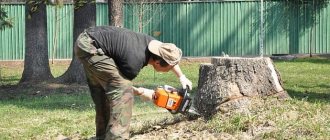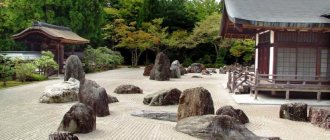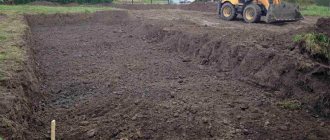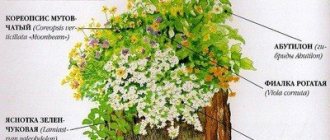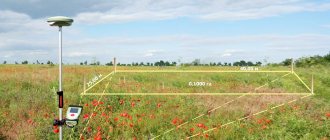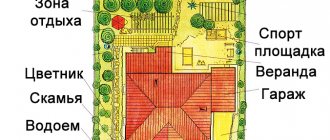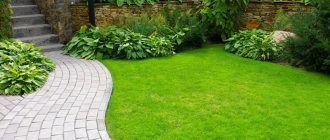Advantages and disadvantages of stump crushing
Advantages of crushing
- There is no need to dig a ditch around the stump.
- High equipment mobility.
- Stump removal is carried out by one or two specialists, which, of course, affects the cost of the work;
- No need for heavy machinery
- After crushing, a small hole remains, which is easy to fill.
- Compact, installation requires little space to work, about one and a half meters.
- The sawdust remaining after crushing is suitable for mulching.
- The process is quite fast, a few hours.
- Stumps of any size can be removed
- Reduce costs by up to 20% compared to other methods;
- There is no need to remove the stump, because it is crushed.
- When crushing stumps, the root system of neighboring trees is not damaged.
- A stump crusher is easier to transport to the work site, unlike an excavator.
- Stump removal can be done in very cramped conditions.
Disadvantages of crushing
- The depth of stump removal is no more than 45 centimeters. In the case of, for example, pouring a foundation, this is very little;
- Any sufficiently hard object, be it a piece of metal or a stone, threatens to damage the expensive crusher equipment.
Natural ways
If it was not possible to get rid of stumps by eroding the soil, there is no need to think that uprooting is now impossible.
There are many other alternative recommendations on how to quickly free your garden plot from “old wood traces”. Many people are interested in this method of planting young seedlings. To do this, make a decent depression in the center of the stump using a drill. Fertilizers are poured into it, and then a young tree is planted in the prepared soil. Further care of the seedling is identical to the care of trees planted directly into the ground.
During the growth process, the root system of the seedling increases and expands. In addition, it begins to pull all the nutrients from the old stump. As a result, the exhausted “old man” simply dies and is destroyed naturally.
You can plant not only young seedlings to destroy stumps. A suitable method is to “infect” the stump with fungal spores. To use this method, it is recommended to strictly follow the step-by-step instructions:
- using available tools, make indentations on the surface of the stump;
- mushroom mycelium is placed in the cracks;
- water generously;
- cover with a bag.
Using this method, you won’t be able to quickly forget about such a neighborhood. The first harvest of mushrooms can be harvested a year after the stump is infected. After five years, the wood will undergo final aging, after which no trace of the old stump will remain.
Mechanized removal - destruction of stumps without uprooting
This method speaks for itself. The manual method has been replaced by heavy artillery - special equipment that significantly facilitates the work of any specialist. No one obliges you to buy it, otherwise destroying one stump on your plot will cost you more than the most expensive removal method. For mechanized destruction, organizations specializing in this type of work are involved.
You can remove a boring stump using an excavator or a tractor , but this method can hardly be afforded in a fenced area with flower beds and a planted lawn. Such large equipment simply cannot get close to it. In this situation, a hand-held power tool, popularly called a stump crusher . In this mechanism, all the work is done by a stump cutter , which cuts the wood to a depth of 30 cm below ground level, turning the stump into ordinary sawdust. It simply dissolves, and sawdust mixed with soil becomes an excellent fertilizer for future dacha needs.
The Arborist will be happy to carry out stump removal using any removal method you choose. We have a set of high-quality and time-tested tools, and our specialists have extensive experience in solving these types of issues.
The “arborist” will help you get rid of the firewood of various tree species (fruit or ordinary) stored on your site. If they bother you, we will buy them from you for a good price and remove them from the territory. We can also remove from your site all logging debris and wood waste remaining after cutting or crowning trees.
CONNECT WITH US
Original ways
If the stump is located in porous soil in the garden, it can be removed by eroding the soil. The skeleton is dug up from all sides with a shovel. A few steps away from it they make a hole half a cube deep. Take out a hose with strong water pressure and direct it to the bottom of the stump. Wet soil will flow into a pre-made hole. A day later, when all the liquid has drained and the roots appear, you can carefully cut them off with a hacksaw. The hole is filled with the same excavated soil. If the area is open, this method will work best.
Gardeners often use another original method. They plant young trees directly into the stump. The frame is shortened to the root and a hole is made in the center. You can use a drill for this. Fertilizer is placed in the recess - peat, ash, humus, sand, manure. A seedling is planted in the hole, which will take nutrients for growth from the old stump.
Among the non-standard methods, blasting is also distinguished. It must be done by a person who has permission for such work and special equipment. Before laying the charge, a tunnel or well is created. They are made either with a drill or by hand with a shovel. Only an explosives technician can prescribe the required amount and type of explosive.
In order not to waste time and energy, you can invite specialists who will help you quickly solve the problem. Arborists use a milling machine. You can buy a special stump grinder. The tool is capable of destroying wood to a depth of 40 cm. It does this carefully, using milling, without touching the roots of greenery growing nearby. You can forget about the problem in an hour. The disadvantage of this method is the high cost of renting or purchasing the instrument.
Manual destruction of roots and stumps
This is perhaps the oldest method, which was successfully used by our ancestors long before we were born. However, it would be wrong not to pay attention to him. Although this process is very labor-intensive, it has one distinctive feature - it costs practically nothing. To implement it, it is enough to have several simple tools available at any summer cottage, these are: a shovel, an ax, a hacksaw, a rope and an extra pair of strong hands. With this method of destruction, you do not need to have any special skills, it is enough to be able to dig, and each of us has this skill.
There are two options in this method:
- Mechanical method, when the destruction of old stumps occurs through conventional digging. To do this, use a shovel to dig it up from all sides, and the roots that appear from the ground are chopped off with an ax or sawed through with a hacksaw (whichever is more powerful). The stump dug up in this way remains to be pulled out of the ground. Here a hand winch with a cable attached to it or an ordinary rope comes to the rescue, but then you will need to attract several more physically strong participants. If the tree was small, then after cutting off the large roots it may be enough to swing it from side to side and knock it on its side. When the stump is large enough, they tie it with a rope or attach a winch cable and pull it. Sometimes the stump comes out of the ground with a loud bang, it’s like uncorking a bottle of champagne, which can completely complete a difficult process.
- Using stump removal liquid (ordinary water), you can get rid of it by washing away the soil. This method works well on sandy or loamy soils. A trench about half a cube is dug around the stump with a shovel. Then, using water pressure from a hose, the soil around the stump is washed away, and the exposed roots are cut off. With this method, the rhizome of the stump is pulled out of the ground more easily, as the soil becomes more pliable. But this method is applicable only in the area where it is possible to supply water with the required pressure.
Stump uprooting, preparatory work
Methods for uprooting stumps are divided into mechanical and chemical, each of which has its own advantages and disadvantages, but they have one thing in common - the need for preliminary preparatory work that will speed up the process of stump removal.
To make uprooting easier, you need to slightly moisten the soil around the stump and dig around the entire circumference of the stump with a bayonet shovel, starting from its base to a depth of at least 30 cm, exposing all the roots of the tree to be removed. As the hole deepens, you need to gradually expand its diameter. It should be taken into account that the roots grow in width approximately to the width of the tree crown, so the circle around the trunk that is dug should follow the projection of the crown, and the diameter of the excavation can be 1.5-2 m.
Important! The roots of cherries and plums grow at a great distance from the trunk and extend quite far beyond the diameter of the crown - this should be taken into account when removing their stumps.
You can expose the roots of a tree with water pressure from a hose, having previously constructed grooves to drain the water, while the soil between the roots will be washed away. Exposed powerful lateral roots need to be cut with a chainsaw or chopped, retreating approximately 40 cm from the stump trunk.
Removal using chemical methods
The advantages of this method are obvious: it is inexpensive, there is no need to involve specialists, the landscape remains intact, and both the above-ground part and the roots of the stump are destroyed. Significant disadvantages:
- the soil is burned. When using chemicals, the soil around the stump is damaged. It will not be possible to engage in farming in this place for several years.
– the process takes a long time. This is one of the significant reasons why this method is not so popular. It may take several years from the start of work to the final result. The stump will collapse slowly.
For whom time is not a problem, we give advice on a chemical method for removing a stump:
We stock up on potassium or sodium nitrate. We drill as many deep holes as possible in the stump with a diameter of 10 to 20 mm and a depth of up to 20 cm. We fill the stump with saltpeter, wrap it with a piece of film or cover it with straw, and leave it like that. You can wait for the stump to rot on its own, but the process will drag on for at least a year and a half to two. After this, all that remains is to break the dust with a shovel. By the way, this method also works with coarse salt. It is worth sprinkling a fresh stump with salt, wait two or three years, and break it up.
The second option: set it on fire after several months. A stump soaked in saltpeter will quickly burn out.
Care should be taken here, as the fire can spread to other trees, so it is better to do this in early spring or late autumn, when the main work in the garden has not started or, conversely, has been completed
SUBSCRIBE TO OUR SOCIAL NETWORK GROUP TO RECEIVE INFORMATION ABOUT NEW ARTICLES ON THE SITE.
Chemical destruction of stumps
There are a number of drugs that can be used to easily get rid of the problem of the remaining stump. But in the chemical method, like a coin, there are two sides. One is that the method is quite cheap and does not require any physical effort on the part of the person who will carry out the removal. It is enough to carry out the preparatory stage of work correctly and everything is in the bag. This is where the second side of the process is shown, namely, the time of destruction of stumps . At first it’s a little scary, because this figure is from six months to one and a half years. There is something to think about. Although, in fairness, it should be noted that with such destruction, any stumps are removed more efficiently, along with the most extensive root system that can be found in a plant. In addition, no harm is caused to the rest of the greenery growing on the site; lawns, beds and soil remain untouched. If you stick to the dosage, it is impossible to harm the soil and other plant roots. Let's look at the types of chemical removal:
- Destruction of stumps with saltpeter is the most common method, a description of which can be found in any specialized literature. Sodium and potassium nitrate are used. The essence of the method is to introduce as much of the drug into the wood as possible. Next year, when the entire stump is saturated with the substance down to the very last root, a fire is lit on it and all the wood burns out completely, even those roots that are deep in the ground. As you know, when heated, saltpeter releases oxygen, which contributes to the complete burning of the stump. Technically, the whole process looks like this: several deep holes are drilled in the stump (noticeably right down to the ground), into which the drug is then poured. The number of holes should be approximately 3:1, i.e. On a stump with a diameter of 30 cm, about 10 holes need to be drilled. Then, covered with saltpeter and filled with water, they are sealed and left for the winter. It is advisable to carry out the process at the end of summer or beginning of autumn; it should not be delayed until the onset of cold weather, since the time of destruction of the stump will also increase. After six months or a year, this stump destroyer will thoroughly saturate the wood and the root system; it will turn into dust, which burns easily without leaving any traces. The only limitation for this method of destruction is the impossibility of carrying it out on peat soils. This could lead to large-scale underground fires, which would be extremely difficult to stop. In other cases, on sandy or clayey soils, nothing will prevent you from using this simple destruction method.
- Urea (or ammonium nitrate) is another drug for destroying stumps, allowing you to remove everything without leaving a residue and even without setting it on fire. Under the influence of this substance, wood undergoes increased self-decomposition to the state of rot. As a result, the stump can be pulled out with a shovel, without any effort or uprooting. In fact, urea itself is a good nitrogen fertilizer, so you don’t have to dig up the stump, just cover it with soil after applying the drug, and after a couple of years you can plant beds or plant a flower bed in this place. The stump will rot in the ground along with the rhizome and turn the soil into a fertile area for future plantings. Urea is added in the same way as ordinary saltpeter, then watered and sealed.
- Destruction of stumps with salt - works in the same way as the previous methods, but instead of saltpeter, ordinary coarse table salt is used. It would seem that what an ordinary pack of salt sold in any store can do, but no, it can. It, like urea, is poured into holes in the stump and filled with water, then sealed and wait for the result. This process may take a little longer, it takes about one and a half to two years, but this method is cheaper and will not harm the soil or other plants on the site. It is difficult to overdo it with the salt concentration, but still be careful when dosing, since it will not be possible to immediately plant other plants on excessively salty soil; you will have to wait another year or two. Just like saltpeter, salt can corrode the wood of a stump into dust, which is then set on fire and the stump burns to the ground.
- Stump killing with Roundup is a systemic herbicide that makes it easy to get rid of weeds, unwanted growth or roots. This is the most common herbicide in the world practice of plant protection products; its main active component is glyphosate. The method of action of the drug on weeds is somewhat different from the destruction of dead tree roots, i.e. stump The drug should be applied in hot sunny weather, with air humidity not exceeding 50%. If it rains after the procedure, it will wash the substance into the ground and the work will need to be done again. For the best effect, you need to treat a freshly cut stump, then the process of cell death will occur much faster. “Roundup” is completely devoid of soil activity, therefore it is harmless for the further growth of any crops, it does not accumulate in the soil, and is also able to fight well against woody shoots that can grow from the roots of a stump that was not removed in time.
- You can also use any herbicide to destroy stumps (Tornado, Glisol, Alaz, Zero and others). To destroy a stump of large or medium diameter, the drug is applied to its outer edges, because the inner part has long been dead (if the stump is not freshly cut). When the stump is small (about 10 cm in diameter), the herbicide is applied to the entire cut. It is also possible to apply drugs directly into the soil. To do this, a solution for destroying stumps is sprayed over the surface of the earth, and the remainder is generously watered onto the roots of the stump. As a result, they die off and no longer adhere so tightly to the ground, so the stump can be easily removed after a certain time. This method is quite effective when you need to destroy a large number of stumps and even trees. You don’t have to wait years to completely eliminate unnecessary wood.
- Another method, similar in its technology to previous methods, is to populate the stump with mycelium (spores) of some edible mushroom. This is not exactly a chemical for destroying stumps, but the process is almost the same. As a result of their vital activity, planted mushrooms destroy the wood and rhizomes, as if “erasing” the stump from the area completely. The destruction process will take much longer, about four years, but you will always receive fresh mushrooms.
With the help of technology
This is perhaps the fastest way. The stump is pryed up with an excavator bucket and pulled out of the ground. In the case of a tree, its frame is tied with a cable and pulled out with the help of a tractor.
The speed of this method is perhaps the only advantage. There are many more disadvantages:
- Hiring equipment is quite expensive;
- Not every site can accommodate such large and heavy vehicles;
- When heavy equipment is used on a site, the top layer of soil is severely damaged; restoring the landscape will require a lot of time, effort and money. Is it worth spending so much money just for one stump?
Stump remover
Special device for uprooting. Can be manual or mounted. A manual uprooter is used to remove young, thin trees and shrubs. Consists of a support platform and a stand with a lever and grip for wood.
- Advantages: carefully and quickly removes young growth without damaging the landscape.
- Disadvantages: it is impractical to buy for personal use for isolated cases, and to rent it you will also have to try - not every household has such a unit.
Stump crushing machine
Self-propelled compact mechanism on wheels with a gasoline engine. Removes stumps by crushing wood to a depth of 30 cm. Suitable for removing single stumps among plantings or buildings. Among the advantages of the method are the speed of work, accuracy and safety - the surrounding landscape, buildings and communications are not damaged.
Disadvantages: the crushing depth is small, only 30 cm. This means that the roots remaining at depth in the future may produce unwanted growth or interfere with plowing the land and laying communications; the use of such equipment is possible only in areas free of various solid debris. The presence of metal objects (bolts, nails, fittings, etc.) in the ground is especially dangerous, as expensive equipment can be damaged.
Uprooting stumps using a winch
Mechanical root removal is another option that is suitable for removing small to medium sized young trees. To remove a tree in this way, it is necessary to carry out preliminary preparation, namely: dig around the object to be removed within a radius of 1 meter or a little more and to a depth of about half a meter, cut off the exposed lateral roots. Then the stump is tied at the base with a cable, and at a sufficient distance from it, a winch is attached to a reliable support, and the pulling process begins. Once the stump is removed, you can do the same to get rid of the roots remaining in the ground.
Advantages of the method: if the farm has the necessary tools (bayonet shovel, crowbar, axe, hacksaw, winch and strong cable), then the method is not expensive. It’s possible to cope on your own without the help of help.
Disadvantages: not every stump can be handled by a winch. It is unlikely to overcome a strong young tree, and even one growing in dense clay soil. Or there may simply not be a suitable object nearby to which it can be attached.
Chainsaw
She can also get rid of a stump without uprooting - the trunk is cut down at ground level. The method is fast and not expensive. It is good if you need to give the site an aesthetic appearance in a short time. But the disadvantages are obvious: only the above-ground part is removed, the remaining roots will give rise to shoots after some time. In addition, it is impossible to plow the ground in the place of the cut stump. And it is not recommended to start construction (remember about the growth).
How to remove a stump from a summer cottage using alternative methods without uprooting it
Alternative methods of stump destruction include the biological method and the “natural” method , each of which has its own advantages.
There are two biological methods for removing stumps from a site - “infecting” the remainder of the cut tree with fungal spores and “colonizing” it with young seedlings . The disadvantage of these methods is the long-term destruction of the stump (about 3 years), but there are a lot of advantages, at least a harvest of mushrooms in the country and young fruit trees.
When choosing the “mushroom” method in the spring, you can harvest oyster mushrooms after 6 months; to do this, place the mycelium sprouted on the substrate into nicks or holes in the wood, and periodically moisten the stump; after 2-3 years, the mushrooms will turn it into dust.
To destroy a stump with growth, you need to drill a hole in its middle of a size large enough to accommodate the roots of a young plant, fill the hole with fertilizer (ash, humus) and plant the seedling. In the future, care for it as if it were a young tree. The roots of the growth will take nutrients from the stump, gradually destroying its wood and root system.
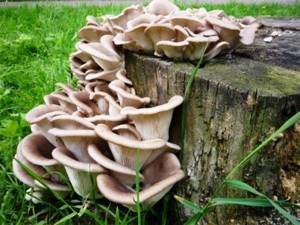
A natural way to get rid of a tree stump in your country house
The natural method of quickly removing a stump from a summer cottage has no disadvantages , but minimal effort, no material costs and 3-4 months of waiting are among the advantages of this method. All you need to do is water the stump generously before the first serious frost. In winter, the water will turn into ice, which will destroy the wood, and in the spring, melt water will saturate the destroyed structure of the stump, soften it and make it rotten and pliable for removal.
How to remove a stump from a summer cottage without uprooting is up to the gardener himself. And it is necessary to remove the remains of cut trees, because after some time the stump can become not only a source of infection and fungus, but also a refuge for pests.
Find out more useful tips from our materials:
- Spring work in the garden. What to do in the garden in May
- Pergola at the dacha: features of manufacturing and placement of the pergola at the dacha
- Whitewashing garden trees - what are its advantages?
- Green manure. What are green manures, types of plants, when, how and why are green manures planted?
- DIY grape trellis
Furniture options
Stumps can be used to make very reliable, high-quality and beautiful furniture. Many options can be built with your own hands at home. Let's look at several schemes for making various furniture from hemp.
Armchair
A very interesting solution is to make a comfortable chair from a large stump. The resulting product can be used to decorate the garden. At the dacha, such garden furniture will definitely not go unnoticed!
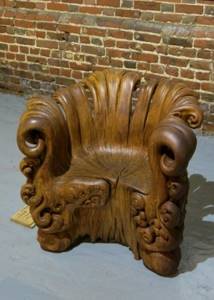
Let's look at step-by-step instructions for making your own chair from a stump.
- First, the master must prepare all the necessary tools. It is advisable to have at least minimal skills in working with the material in question.
- To make a chair, it is better to use a stump 40-60 cm high from the ground. If you cut the workpiece from the trunk yourself, you need to take a higher height. For example, for a 50 cm chair you will need a 100 cm blank, because the furniture will also have a back.
- Next you need to form a support for your back. A horizontal incision is made at seat level. The cut will need to be made to a depth of 2/3 of the trunk. You should saw through from the side that the chair will then “look” towards.
- To form the back, a vertical cut is made from the top until a horizontal cut is reached. The cut piece must be removed.
- The base is ready. Now the chair needs to be decorated. At this stage, the master will need a chisel and a grinder. It all depends on what kind of decoration you want to apply to your homemade furniture.
Bench
Stumps can be used to form an excellent bench on wheels. Using a chainsaw, you need to cut the stump so that both the upper and lower cuts are parallel to each other, but perpendicular to the axis line. Let's take a step-by-step look at how to proceed.
- Both surfaces will need to be well leveled with an electric plane or sander.
- The bark can be removed or left - the master decides everything.
- The cleaned tree can be decorated as you wish.
- You can put a piece of foam rubber on the top of the bench and beautifully cover the base with leatherette. As a result, the bench will look like a cozy pouf.
- You can build a coffee table using approximately the same scheme, but for this you will need a stump with a more impressive difference in circumference (between the above-ground and underground parts). The underground half, which is located above the level of the roots on the sides, will serve as the top, and wheels must be attached to the upper cut.
Decorative table
Using hemp, you can build a wonderful decorative table that will look very original and interesting. This piece of furniture will definitely refresh the environment.
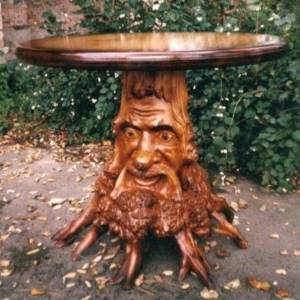
When making a table from hemp, the main problem is the choice of tabletop material. It is not so easy to find a stump with a top diameter of 80 cm or more, and then make a perfectly even cut with a suitable thickness. For this reason, countertops are often made from other materials, for example:
- board made of boards;
- Chipboard, OSB;
- glass;
- plexiglass.

To attach a beautiful glass tabletop, you need to use a special adhesive composition based on epoxy resins. Degreasing components will also be needed. Sometimes craftsmen will first glue the epoxy cap, and then level it until they achieve the desired plane. Then the tabletop is glued using a special glue for glass.
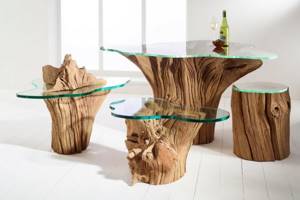
Cross cut
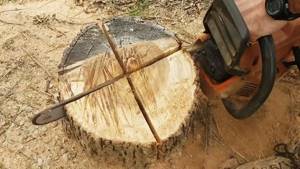
Next, the top is divided along the top into four parts in the shape of a cross. This should be done with a chainsaw (in fact, the only tool required for this work).
While renovating a house, a couple discovered a well in the floor: they covered it with glass and left it
Who Shouldn't Eat Honey and Why It's Not an Elixir of Health
The boy lost his toy in the store. Soon the character became “employee of the month”
Means used
Destruction of stumps in a garden plot is possible without uprooting, which requires a lot of effort. Chemical exposure will give a good, albeit not quick, result.
Urea and saltpeter
The stump must initially be holed: perforation with drills will not be a problem. Urea (this is urea) is poured into the holes formed by drilling. The top of the holes is filled with water, and then the stump is wrapped with a polymer film. The remaining wood will completely rot in a year, maybe two. And in place of the former stumps there will remain a usable, fertile soil layer.
The advantages of this method are minimal physical costs, the absence of soil contamination with nitrates, and the fact that in the end there will be no trace left of the stump. The main disadvantage is, of course, the inability to remove the rest of the tree quickly. And a lot of chemicals will be required for burning. Saltpeter is an even more popular method for destroying a stump. It consists of burning those wood residues that were initially impregnated with such a strong oxidizing agent as saltpeter. This product helps to burn out not only the upper parts of the stump, above ground, but also the deep roots.
How to use saltpeter to deal with stumps:
- drill several large holes in the remaining wood (do this at the end of summer or early autumn);
- Potassium nitrate should be poured into the holes to the very top (sodium nitrate is also suitable), and then poured with water to understand how saturated the wood is;
- The top of the hole must be covered with wood plugs and wrapped in polyethylene.
And again the stump is left in the same form until the summer. In a few months, the saltpeter will serve its purpose and the root system will dry out. And again, you need to make a fire around the stump, and this fire will completely destroy the frame. After burning out, the area where the stump was located must be dug up and covered with earth. The main advantages of using saltpeter: the absence of much effort, almost complete removal of the skeleton (it may not be possible to completely remove very deep roots). The downside is the saturation of the soil with saltpeter. Although it is a fertilizer, in large quantities it causes damage to tuber crops, and fruit crops too. And, again, you will have to wait a long time for the stump to rot. You also cannot do without ignition, which is not particularly pleasing.
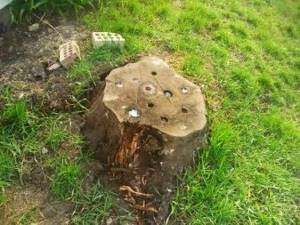
Copper and iron sulfate
This substance is an active reagent that kills any bacteria in wood. The drug must be introduced into the structure of the tree in the same way as was done with saltpeter. But there are some differences: holes in the stump are made 5-8 mm in diameter and to a depth of 5-10 cm. Vital activity in the wood dies out quickly, in a few days, but the stump will die off completely in 1-2 years. When this time has passed, the stump needs to be excavated along with the roots, uprooted (which will be very simple at that time) or burned.
Attention! If there are metal pipes next to the stump, vitriol cannot be used. It will only accelerate metal corrosion
You can plant other plants on the site, but maintain a distance of at least 3 m: in the area where vitriol is used, the concentration of chemicals is high.

Salt
It is considered one of the gentlest chemical methods. In just a couple of months (sometimes one is enough), the reagent blocks the vital activity of roots and microorganisms. Adding salt is similar to adding saltpeter and urea. If this area is subsequently to be filled with concrete, the dead stump will be easier to burn.
If the site is to be used as active fertile land, the dead stump must be uprooted. Salt in excess makes the soil unsuitable, so leaving the stump until it self-decomposes is dangerous for the future harvest. For reference: 1 stump takes about 2 kg of table salt. Salt is sent into the drilled holes and filled with water. If there is high humidity outside, you can do without water.
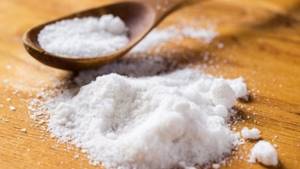
Burning by fire
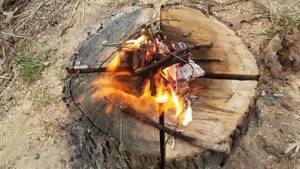
In many cases, the measures taken at this point will be enough to completely burn the stump. But if the wood structure is hard and damp, then additional measures will be required. Another source of flame, organized from above, will help to increase the efficiency of the process.
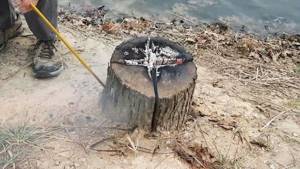
Dry and dense brushwood is laid out right on top. Igniting it will enhance the thermal effect. As it burns, you can also add thin, hard wood, the coals of which will fall into the cracks.
Unsung heroes: Alexey Malakhov spoke about the everyday life of an “infectious diseases” doctor
Coffee and tea are an ideal means of delivering probiotics to the body
"The Power of Blood" “Kitchen” star Maria Gorban showed a photo with her mother and daughter
If the flame decreases, do not panic. This is normal, since the process of smoldering and slow destruction of the wood structure from the inside will continue its work. In good weather, you can safely leave a smoldering stump without additional firewood.
Burning a stump.
This is a fairly quick way to remove a stump. Unlike soaking a stump with saltpeter, this method does not require much time and leaves the roots of the stump intact in the ground. To avoid underground fire, this method cannot be used on peat soils.
There are two ways to burn a stump.
You can install a metal barrel without a bottom on a stump. You need to periodically burn garbage in this barrel and over time the stump will burn out completely. This method works best on a fresh, recently cut down stump.
You can make a so-called Finnish candle from a stump. This method is suitable for dry stumps. Fresh stumps will often go out.
First, a hole is drilled in the center of the stump. The hole diameter should not be too small. A diameter of 20mm or more is best.
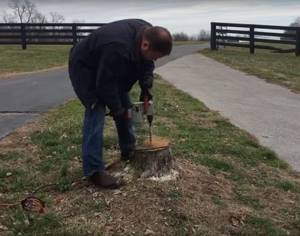
Drill a hole in the center of the stump.
Once on the side of the stump, you need to drill a second hole so that it connects to the first hole. This side hole is necessary to supply air to the combustion zone. For better air supply, you can drill several side holes.
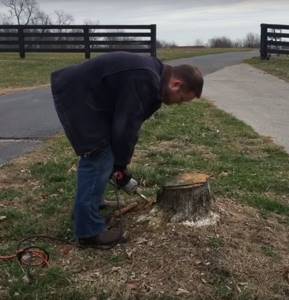
Drill side holes in the stump
Pour 100-200 ml of diesel fuel or charcoal lighter fluid into the hole, which is used when preparing barbecue.
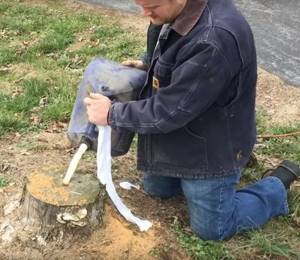
Pour flammable liquid into the hole.
We make a wick from cotton fabric and moisten it with flammable liquid. We lower the wick into the hole.
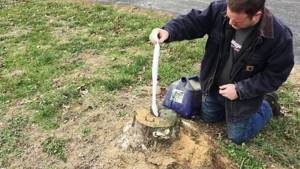
We make a wick.
We light the wick and wait until the entire stump burns out.
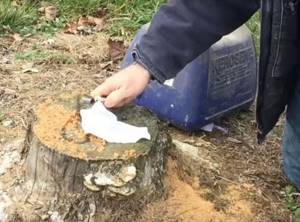
Light the fuse.
If the stump does not ignite the first time, then you need to add small dry branches and repeat the arson again.

The stump caught fire.
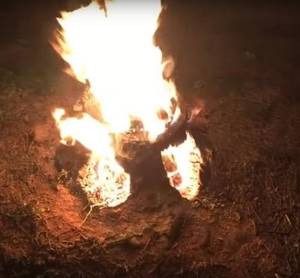
The stump caught fire.
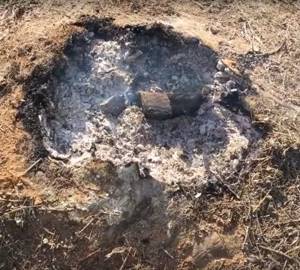
All that remains from the stump is a pile of ash.
How to get rid of an unnecessary stump on a personal plot without uprooting
Why uproot old stumps? There can be many reasons. It happens that people want to plant a new garden on their plot, but old stumps do not allow this or simply redevelopment. Sometimes, there is a need to remove a tree that is in disrepair. It happens that a stump interferes with the creation of a landscape composition or interferes with the planting of a vegetable garden or flower bed. In all these and many other cases, to achieve your goals it is necessary to get rid of stumps.
It is worth mentioning that if the stump is located at a great distance from other trees and does not bother anyone, it can be left to decay naturally or decorated, turning it into a landscape design object. If the stump is located close to healthy trees, it is better to get rid of it, since bacteria that destroy the stump, fungal spores, and woodworms can move to other trees.
Loading…
Before you begin the procedure of getting rid of an old stump , you should consider some important points. Each type of tree has its own root structure. Spruce, for example, has a shallow fan root system (similar to how its branches grow). That is why in the event of hurricanes or other natural disasters, the spruce tree falls first. For the same reason, it is not recommended to plant a “New Year tree” near the house and other buildings. But uprooting spruce roots is much easier than any other.
Pine, in turn, on the contrary, has a powerful tap root that goes deep. Like the pine trunk (tall, straight, going up), the root has a similar structure. To get rid of such a stump, you will have to make an effort.
As for deciduous trees, they can not only have powerful superficial roots, but also those that go deep (a spherical crown of the tree and the same root system).
There are several ways to remove stumps:
– mechanical (using special equipment, using a chainsaw or stump grinder);
– use of chemicals (nitrate, urea, table salt, etc.);
– manually (using shovels, axes, hacksaws or by eroding the soil).
Let us dwell in more detail on the least expensive methods of uprooting unnecessary stumps , namely manually and using chemicals..
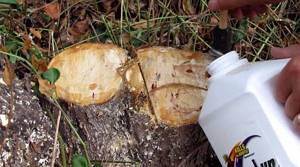
First you need to take a thin, strong metal rod about 40-50 cm long and tie it to a stick (for convenience). After this, you need to generously spill the soil around the stump and use a pin to determine the location of the thickest roots around the stump. Such a simple study will help determine which method is best to get rid of an unnecessary stump.
There are several ways to get rid of an unnecessary stump without uprooting.
Some gardeners resort to the method of destroying a stump with the roots of young trees (they plant seedlings directly into the stump and the growing young growth slowly destroys the stump). Everything is simple here. To begin with, you need to cut down the old stump at the root and hollow out a hole in the center of the trunk. This is easy to do with a drill. The resulting depression must be filled with a mixture of fertilizers (ash, humus, peat, sand, manure, etc. are suitable).
It is necessary to plant a seedling in the prepared “soil”, and then care for it in the usual way. Thus, the young plant will feed on useful substances from the remains of the old stump, thus destroying its wood and rhizome.
You can also get rid of an unnecessary stump on your garden plot without uprooting it if you plant fungal spores in it . To do this, you need to make a couple of cracks in the cut of the trunk and put the mycelium of fruiting myceliums into them (this can be oyster mushrooms or honey mushrooms). After this, the stump should be watered and covered with film.

Thus, next year you will have a fertile mycelium that can produce crops for up to 5 years. After it stops bearing fruit, the wood will dry out and the unnecessary stump will be easy to remove. This method of getting rid of a stump will prevent the appearance of growth from old roots, which is also a definite plus.
An effective remedy in the fight against an interfering stump is kerosene . A hole is made in the center of the stump (diameter and depth depend on the size and height of the stump). You need to pour regular kerosene into the resulting hole and add it little by little throughout the day, as it gets absorbed. The hole must be tightly sealed with a wooden stopper (just a wooden block will work fine). After this, all that remains is to leave the stump in this state for a couple of weeks.
After the specified time has passed, you need to open the plug, taking precautions, and set fire to the hole and the kerosene that has soaked inside. Thus, the stump will be safely destroyed to the ground without much difficulty and grueling uprooting.
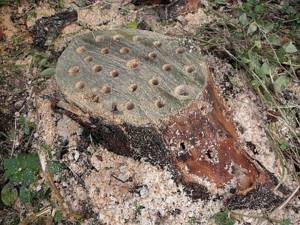
There is another effective way to uproot a stump on a personal plot, which does not require much effort (but here you will have to be patient).
The stump can be destroyed from the inside using simple chemical reagents, for example, potassium or sodium nitrate . This method is easy to use and completely utilizes the entire root system down to the last smallest root. The size of an unnecessary stump only affects the time it takes for its wood to decompose.
The downside is that this method is quite lengthy. It may take several years from the start of the process to its complete completion. But during the procedure, young growths that always interfere will not appear, and this method of stump removal is not expensive. It is best to resort to this method in the fall, during the period when it is customary to restore order at your dachas.
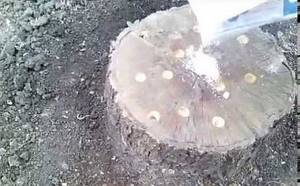
First you need to drill several holes in the stump (10-15 cm deep and 20-25 cm in diameter). Next, you should pour potassium nitrate into the resulting holes (it must be poured so that the level does not reach the top a couple of centimeters). After this, for a faster effect, you need to very carefully seal the holes. Garden pitch or paraffin is suitable for this. After this, cover the stump with plastic wrap and tie it with a rope (so that the saltpeter does not wash away with water). And then it’s a matter of time. Over the winter, saltpeter and the weather will do their destructive work - the stump will turn into dust.
In the spring, you can safely remove it from the site without uprooting it. If the stump is very large and old, then one winter may not be enough to destroy it. Sometimes there is advice to set such a stump on fire in the spring to make it easier to uproot. To do this, the stump is opened and uncorked, after which kerosene (or other flammable substance) is poured into the holes and set on fire.
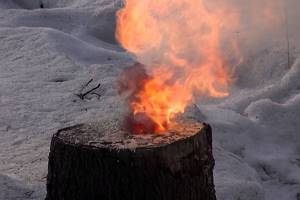
When burned, saltpeter releases oxygen, causing the fire to spread deep into the soil, burning the entire root system. After this, all that remains is to dig up the place where the stump was removed and use it in the future at your own discretion. But this method, like any other where fire is used, can be dangerous, since wood soaked in saltpeter can burn even deep underground (where the roots reach), which, for example, in old apple trees can be very long and stretch under the vein house or other buildings.
You can get rid of an unnecessary stump using ammonium nitrate. This substance is popularly called “urea” and is successfully used to remove stumps in garden plots. This substance both decomposes wood and roots and is a good soil fertilizer. After the decomposition process is complete, the stump can simply be covered with soil and used to plant a flower bed or vegetable garden. This method is carried out similarly to that described above, only urea is poured into the hole and the stump is not set on fire after decomposition of the wood (this makes it possible to use this type of destruction even on peat soils, where ordinary saltpeter with burning is unacceptable, due to the high fire hazard of peat soil).
Without much effort, you can get rid of a tree stump in your dacha using regular salt. This is perhaps the easiest way to decompose wood. To carry out the procedure, you will need regular coarse table salt (approximately 300 g per small or medium stump). In this case, the “killing” of the wood will also occur without the formation of shoots.
Salt is poured into prepared holes (you can pour it into natural cracks or drill holes with a drill), pour plenty of water, wrap it up and leave it for the winter. After this, the remains of the stump are covered with earth and it decomposes in the ground itself. After carrying out such a procedure, the area where the stump was located becomes unsuitable for planting a vegetable garden or flower bed for several more years (due to “over-salinity” of the soil), but this is not a problem if you are not going to plant anything there right away.
When it comes to a well-maintained garden, mechanical removal methods are generally inappropriate. This is simply impossible to do, so you have to choose between chemical and manual uprooting methods.
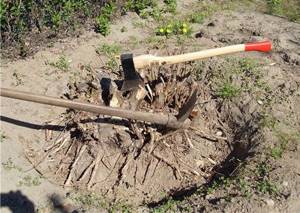
If the stump is small, then it will be faster to carry out the process manually than to wait several years for the wood to decompose. On the other hand, if there is no particular rush, you can choose the most optimal chemical method, with which you can destroy all the roots and avoid the appearance of annoying growths. Any of the methods will bring better results than if you leave everything to chance.
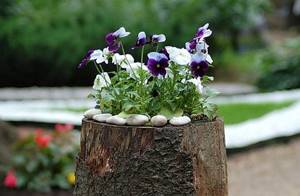
If the goal is not to get rid of the stump, but to improve the garden area, then the stump (if it is large enough) can be turned into a beautiful and even functional item of garden landscape design, for example, a table, chair, original sculpture, etc. This already depends on the enthusiasm and flight of imagination of the owner.
Source
When can you burn stumps?
Bacterial infections that affect the roots and trunks of trees cannot be destroyed by uprooting, because even a small piece of root remaining in the ground contains these bacteria.
In addition, pathogens are found in the soil surrounding the roots, so even complete removal of the root system does not make the soil safe for trees.
To avoid this, it is necessary to destroy the infection in the roots and soil, for which the soil is treated with aseptic substances or heated to a temperature that leads to the death of bacteria.
Treatment with aseptic substances is not always effective, especially on clay soils, due to poor water permeability, so burning is a more reliable way to destroy a stump.
Stumps are also burned if it is impossible to remove the butt and roots by other means. This is especially true in cases where cutting and uprooting do not lead to the death of the root system and after some time new shoots appear from the roots remaining in the ground, and treatment with herbicides that kill the plant is for some reason unacceptable.
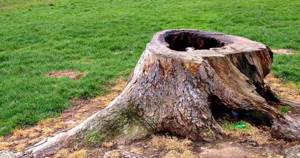
Other removal methods
If it is impossible to burn the stump for some reason, then use one of these methods :
- Uproot the stump manually; we talked about how to do this here.
- Contact an organization that deals with uprooting. There they will offer you different techniques to do the job, as well as different methods for removing the stump.
We talked in more detail about the methods of mechanical uprooting, as well as the equipment necessary for this, here.
You will find detailed information about the cost of work and addresses of enterprises in major cities here.
Security measures
When working with saltpeter, you must be careful. During the processing process and in the following months, it is strictly forbidden to smoke or make fires near the stump. Copper/iron sulfate in a dry state is safe for human skin
However, during processing you need to use goggles, a respirator and gloves (when water is added to the preparation, a toxic liquid is formed that negatively affects the mucous membranes). Table salt is safe when dry and takes a long time to dissolve in water. You can work with round crystals without following safety precautions. When treating stumps with fine salt particles, you should protect your eyes with goggles. A slight gust of wind can blow the composition into your eyes. How to remove a stump chemically and avoid negative consequences? While burning a stump treated with chemicals, we form a small earthen mound 50 centimeters high around the pit - this will prevent fires. Be sure to have a fire extinguisher on hand, as well as a hose connected to the water supply. When wood is burning, you should not stand on the leeward side - toxic substances are released into the atmosphere, which are harmful to inhale. Experts recommend that before burning a stump, obtain a special permit from the nearest department of the Ministry of Emergency Situations. Otherwise, you may receive a large fine. Glyphosate-based preparations cannot be used for destruction. They kill wood, but do not decompose, even after a long time. They get into plants and harm all living things.
Boarding schools are closed for quarantine
— Are there any positive changes in the PNI system?
— Due to the coronavirus, there was not just stagnation, but a certain setback on the path to progress. It is currently planned that a new decree on inpatient social service organizations will come into force on January 1, 2021. It says that organizations will be required to arrange the daily life of residents differently - this is due to changes in Sanitary Regulations and Regulations - and that buildings should be arranged not as a barracks type, but as an apartment one.
According to this document, organizations will have to do their best to encourage people to study and get jobs outside the PNI. That is, they want to make the socialization of patients one of the responsibilities of boarding schools, so that managers understand that people here are not imprisoned for life. Let's just say that if a person needs less care and if he is ready to take on more responsibility, then he can probably leave the walls of the boarding school.
This is a big step, but the problems will not disappear overnight.
It seems to me that due to the coronavirus, innovations will be postponed for objective reasons: boarding schools are closed for quarantine, and any movements have been stopped.
How to compensate for this later is another matter.
My fellow boarding school directors and I discussed our plans for 2021 and decided that we first needed a strategy session to determine how we could move forward in such a limited format. We really hope that the vaccination situation will not drag on for long, but for now we have what we have. We will try to change something.

“We’ve been dreaming of getting married for 18 years, but they don’t let us.” Lovers from PNI - about how to be together while living in different rooms
Persistent problems independent of the pandemic are not going away either. We summarized them from the residents' words. Naturally, the lack of personal space comes first. Secondly, either patients do not have personal belongings, or these things disappear from them. If I live on the same floor with 75 people, it's inevitable that something will be stolen or damaged from me. For every person, personal belongings are part of their identity, and it is very traumatic when you cannot be sure of their safety. The next problem is the ban on intimate life (Pravmir has already written about this. - Ed. note.
). And the last thing is the closed doors of departments and boarding schools. Patients do not have full communication with the outside world.
— Is it possible to solve these problems and what has already been done?
- Yes, of course, we always start by opening the doors. Believe me, nothing terrible happened in those boarding schools where they are already open. People who were locked up began a completely different life: a person goes to school, goes to work, visits relatives. As for the rest, we cannot influence this in any way if the boarding schools are not resettled. But this can only be resolved over the years, if some new government organizations of a small format appear.
— Articles about the problems of psychoneurological boarding schools often cause a lot of negativity. What is the reason for this and is any work being done to change the attitude towards PNI patients in society?
“Unfortunately, fear of people with mental illness is a phenomenon of our time. We carried out various destigmatization programs - for example, educational, training - but they had minimal effect.
Researchers understand that as long as PNI patients remain living behind the fence, society will continue to perceive them as potentially dangerous or dysfunctional and think that they are so different from healthy people that they cannot start families, although this right is enshrined in the International Convention on the Rights of Persons with Disabilities , which was probably not written by fools.
The situation will change when these people leave the boarding schools and when their neighbors become convinced from their own experience that they are safe - as is happening now in assisted living projects. But there is no way to prepare society in advance; all modern research shows this.
Security measures
Ammonium and potassium nitrate are explosive flammable substances, so they must be used with extreme caution
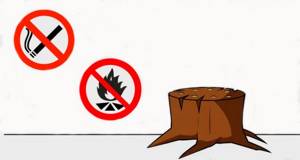
Do not smoke while working with them. 1–3 months after the laying of nitrate, active processes occur in the wood associated with the release of flammable gases, so you should not smoke or light a fire near a stump treated with these reagents.
Copper and iron sulfate in a dry state are safe for human skin, but when working with them you must use a respirator, goggles and gloves.
Table salt is safe in its dry state and takes a long time to dissolve in water. When working with coarse salt, no safety precautions are required, but when working with fine salt, you need to use glasses, because an unexpected gust of wind can blow it into your eye.
To reduce the risk of fire when burning a stump and roots, it is necessary to pour a circular earthen bank ≥50 cm high around the pit. Burning wood should not be left unattended, because it can shoot quite large sparks that fly 5–10 meters and go out only after a few minutes.

In addition, you should always have a fire extinguisher on hand and, preferably, a hose connected to the water supply - this will help extinguish an incipient fire far from the stump.
You should not stand on the leeward side of burning wood, because it, impregnated with saltpeter or urea, releases toxic substances when burned.
In addition, it is advisable to obtain permission from the nearest department of the Ministry of Emergency Situations to burn the stump, otherwise a large fine may be issued. You will find more information on this issue in this article (Combustion).
Do not use other substances for chemical exposure, especially those based on glyphosate (Roundup, Typhoon, Santi). They effectively kill wood, but do not decompose in the ground, so they first enter new plants, then with their fruits into the human body.
Chemical etching
Every second or third summer resident has saltpeter or urea in their utility room. You won’t have to blow up the “stocky” one, but poisoning is always welcome. Moreover, the “mineral water” poisons with a bang: when a chemical substance gets into the living structure of a plant, every part of it dies. You just have to wait until the end of summer or the beginning of autumn to start the event:
- You need to arm yourself with a drill and a long wood drill with a diameter of at least 1 cm (so that it is convenient to press mineral granules into the finished holes);
- Dozens of holes are drilled into the stump (the deeper, the better);
- The stump is watered because a humid environment accelerates the dissolution of the drug and its burning sensation;
- The holes are filled with granules;
- Wedge plugs are driven into the holes to seal the chemical reaction.
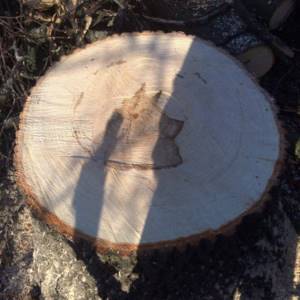
It is better to use urea, because... its nitrogen concentration gives a head start to a similar concentration of ammonium nitrate. Even better is to purchase Tornado or Roundup herbicide. From them all the roots are guaranteed to burn in the spring.
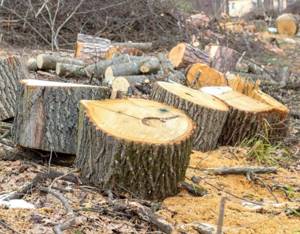
True, such removal of stumps from an area often results in soil damage, i.e. excess of harmful reagents in it. Therefore, gardeners are accustomed to limiting themselves to mineral fertilizers or table salt. The latter must be used in a volume of 700-1000 g per 1 cubic meter. m of wood.

